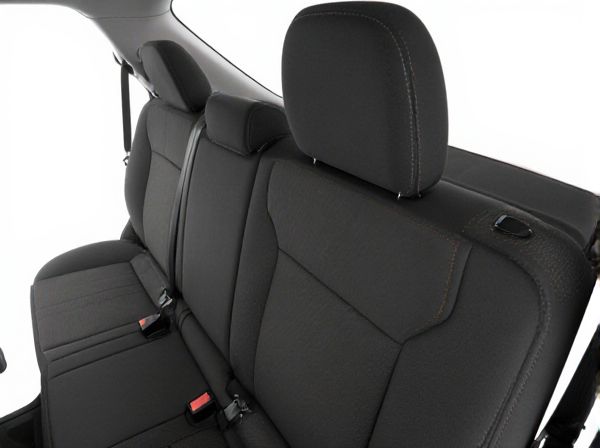
Photo illustration: Split-folding Seat vs Full-bench Seat
Split-folding seats offer enhanced versatility by allowing you to fold down individual sections to accommodate both passengers and cargo, making them ideal for transporting larger items without sacrificing seating capacity. Full-bench seats provide a continuous seating surface, maximizing passenger capacity but limiting flexibility in cargo arrangements. Choosing between them depends on whether you prioritize adaptable space or consistent seating for passengers.
Table of Comparison
| Feature | Split-Folding Seat | Full-Bench Seat |
|---|---|---|
| Flexibility | High - Allows independent folding for varied passenger/cargo configurations | Low - Entire bench folds together, limiting customization |
| Passenger Capacity | Typically 2-3 seats, adjustable seating space | 3 seats, uniform bench style |
| Cargo Space | Expandable by folding sections individually | Expanded only when entire bench folds down |
| Convenience | Better for mixed cargo and passenger use | Simpler but less versatile |
| Common Usage | Modern SUVs, sedans, and crossovers | Older models and basic trims |
Introduction to Car Seat Configurations
Split-folding seats provide enhanced versatility by allowing individual sections of the rear seat to fold down independently, optimizing cargo space without sacrificing passenger capacity. Full-bench seats offer a continuous seating surface, maximizing passenger accommodation but limiting flexibility in cargo arrangement. Understanding these configurations helps drivers choose vehicles that balance passenger comfort with practical storage needs.
What is a Split-folding Seat?
A split-folding seat is a car seat design that allows the seatback to be folded down in separate sections, typically in a 60/40 or 40/20/40 split configuration, enhancing cargo flexibility without sacrificing passenger seating. This design enables drivers to fold one or more portions of the rear seat to expand the trunk space for larger items while still accommodating passengers. Split-folding seats optimize interior utility, making them a practical feature for families and active lifestyles requiring variable storage and seating arrangements.
What is a Full-bench Seat?
A full-bench seat is a continuous bench seating arrangement that spans the entire width of a vehicle's interior, typically found in older trucks and some classic cars. Unlike the split-folding seat, which allows individual seat sections to fold independently for increased cargo flexibility, the full-bench seat offers a single, uninterrupted seating surface for up to three passengers. This design maximizes seating capacity but limits customization for cargo space compared to split-folding configurations.
Key Differences Between Split-folding and Full-bench Seats
Split-folding seats enable independent folding of seat sections, enhancing cargo versatility and passenger accommodation by allowing partial seat storage while maintaining some seating. Full-bench seats provide a continuous, single-piece design, maximizing passenger seating capacity but limiting flexibility for cargo space adjustments. Key differences include adjustability and usage; split-folding seats prioritize adaptability, whereas full-bench seats emphasize uniform seating alignment.
Space and Cargo Flexibility
Split-folding seats enhance space and cargo flexibility by allowing individual sections of the rear seat to fold independently, accommodating passengers and varying cargo sizes simultaneously. Full-bench seats provide a continuous seating surface but limit cargo options, as folding the entire bench is necessary to increase storage space. Vehicles equipped with split-folding seats offer greater adaptability for transporting bulky or irregularly shaped items without sacrificing passenger capacity.
Passenger Comfort and Accessibility
Split-folding seats enhance passenger comfort by allowing customizable seating arrangements and increased legroom when sections are folded down, accommodating varying passenger and cargo needs. Full-bench seats offer simplicity and maximum seating capacity but may limit individual passenger comfort due to fixed positioning and reduced flexibility. Accessibility improves with split-folding seats as they provide easier access to rear cargo space without requiring passengers to exit the vehicle.
Convenience in Daily Use
Split-folding seats offer enhanced convenience by allowing partial seatbacks to fold down independently, creating versatile storage options without compromising passenger space. Full-bench seats provide uniform seating but lack flexibility for carrying larger items while accommodating passengers simultaneously. Drivers and passengers benefit from split-folding seats in daily use by easily adapting the interior to varying needs, improving comfort and functionality during routine trips.
Impacts on Vehicle Design and Aesthetics
Split-folding seats enhance vehicle design by allowing flexible interior arrangements, optimizing space for passengers and cargo, which contributes to a versatile and functional cabin aesthetic. Full-bench seats promote a seamless, continuous seating surface that supports a classic, streamlined look but limits adaptability for varying passenger or cargo needs. The choice between split-folding and full-bench seats influences interior styling, comfort, and overall vehicle utility, impacting both ergonomic design and visual harmony.
Which Seat Type is Better for You?
Split-folding seats offer versatile cargo and passenger configurations, allowing you to fold down sections individually to maximize storage space without sacrificing all rear seating. Full-bench seats provide continuous seating for more passengers but limit flexibility in cargo management since the entire seat folds down at once, if at all. Choosing split-folding seats is better for those needing adaptable space for larger items, while full-bench seats suit those prioritizing maximum passenger capacity.
Conclusion: Choosing the Right Seat Configuration
Split-folding seats offer versatile cargo and passenger arrangements, ideal for users needing flexible storage options and easy access to the rear area. Full-bench seats maximize passenger capacity by enabling continuous seating across the vehicle, making them suitable for larger families or groups. Selecting the right seat configuration depends on balancing space utility with passenger needs, where split-folding suits multifunctional use and full-bench supports maximum seating.
 caratoz.com
caratoz.com